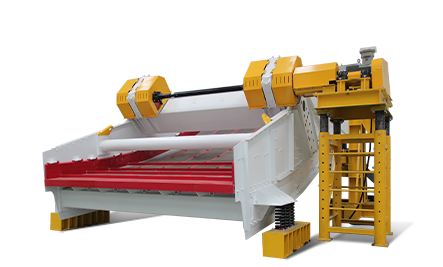What is the installation process of the linear vibrating screen
The linear vibrating screen has been widely used in coal screening in the coal mine industry,and the material from the feeder is evenly sent to the entrance of the screening machine.Through multi-layer screens,several screens and screens are produced.The objects are then discharged from their respective outlets.The linear vibrating screen uses vibration motor excitation as the vibration source,so that the material is thrown onto the screen and moves forward in a straight line.From the feeder,the material enters the feed inlet of the linear screening machine evenly through multiple layers.So how do we install the linear vibrating screen correctly?
Installation steps of linear vibrating screen
1.Place the machine on a flat and firm level floor(concrete or steel structure floor),then insert the anchor bolts(the base bolts are provided by the user)and fix it.
2.The spring is placed on the upper and lower seat ring(place the screen),the spring should fully enter the spring seat to ensure that it is vertical and not twisted.
3.The vibration part of the screening machine must not be rigidly connected or contacted with other objects outside the machine.
4.The motor can be installed horizontally and should be fixed on the installation surface to ensure that the installation surface is smooth and flat.
5.The motor lead adopts four-core rubber cable YZ-500V.When the power supply is connected,the lead cable is not allowed to have sharp folds and be securely fixed with the vibrating body.
6.The motor should have reliable grounding.There is a grounding device in the motor.There is a mark on the front end.It can also be fixed with a strong anchor.
7.Adjust the exciting force.The linear vibrating screen will vibrate greatly when it is opened or stopped through its vibrating area.In order to improve this situation,you can connect an electric brake device.
Installation of linear vibrating screen
1.Note that you must choose a screen with a larger wire diameter,because the installation of a linear screen is relatively cumbersome.
2.When cutting,the screen width should be the same as the net frame,and the length must be 50~70mm longer than the net frame.
3.When installing,the screen must be tightened,because the tightness of the screen is an important factor that affects the screening.
4.When installing a clear net pinball,you must pay attention to the difficulty of screening the material and the number of meshes,and you cannot install it blindly.
5.If the specific gravity of the material is large or the mesh number of the screen is high,a suitable supporting mesh should be added under the screen.The purpose is to play a supporting role,reduce the pressure of the material on the screen,and prolong its service life..
6.After the mesh frame is assembled to the screen box as required,remember to extend the grown screen into the corresponding outlet to avoid mixing.
7.When installing the pressure plate,be sure to pay attention to its flatness,and line it with a more flexible sponge sealing tape to evenly lock it,because this is the key to preventing mixing and an important factor that affects the service life of the screen.
Installation of other parts of linear vibrating screen
1.Since the tension of the vibrating screen will directly affect the screening,the screen must be tightened and then installed.
2.When clearing the net bouncing ball,consider the number of meshes of the material and the difficulty of screening,and add the bouncing ball appropriately,not blindly.
3.If the mesh number of the screen is relatively high or the proportion of the material to be screened is relatively large,a layer of trawl with a suitable mesh size needs to be added under the screen to play a supporting role,thereby reducing the material to the screen.Pressure can also extend the service life of the screen.
4.The net frame is installed in the screen hammer breaker box as required,and the end of the screen should be extended into the corresponding outlet to avoid mixing.
5.After installation,you should use a little material to test the cloth and screening of the screen.If the material is transported forward uniformly,and the classification is accurate,there is no mixing phenomenon,then it can be put into use;on the contrary,if there is deviation or deviation For unevenness such as accumulation,the flatness and uniformity of the screen surface of the screen should be adjusted;if there is a mixing phenomenon,the sealing of the screen and whether it is compressed should be checked.




.jpg)



